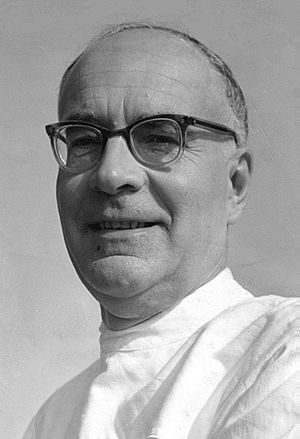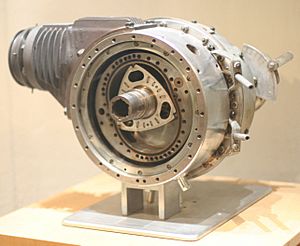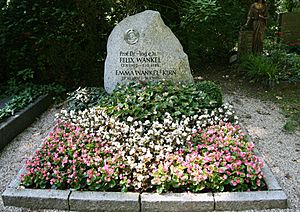Felix Wankel facts for kids
Quick facts for kids
Felix Wankel
|
|
|---|---|

Wankel in the 1960s
|
|
| Born | 13 August 1902 |
| Died | 9 October 1988 (aged 86) |
| Nationality | German |
| Occupation | Engineer |
| Spouse(s) | Emma "Mi" Kirn |
| Parent(s) | Gerty Wankel and Rudolf Wankel |
| Engineering career | |
| Discipline | Mechanical engineering |
| Institutions | Paki, Reich Air Ministry, Goetze AG, NSU, Wankel GmbH |
| Projects | Wankel engine |
Felix Heinrich Wankel (born August 13, 1902 – died October 9, 1988) was a German mechanical engineer and inventor. He is famous for inventing the unique Wankel engine, which was named after him.
Contents
Early Life and Big Dreams
Felix Wankel was born in 1902 in a town called Lahr in Germany. His father passed away during World War I, and his family later moved to Heidelberg. Felix went to several high schools but left without finishing in 1921. He then worked at a publishing house.
Even though he couldn't afford university or an apprenticeship, Felix was very smart and taught himself about machines. He loved learning about combustion engines, which are the powerhouses of cars and other vehicles. When he was just 17, he told his friends he dreamed of building a car with a "new type of engine." This dream came true! He first thought of the Wankel engine in 1924 and received his first patent for it in 1929. A patent protects an invention, meaning others can't copy it without permission.
Felix Wankel and Politics
In the early 1920s, Felix Wankel was involved with some political groups. He joined the Nazi Party in 1922, which was later banned. He also led youth groups that were connected to these political organizations. These groups focused on activities like military training and scouting games.
Later, Wankel had disagreements with some leaders in the Nazi Party. He was even arrested and put in jail in March 1933. However, he was released in September 1933 with help from a friend who knew Adolf Hitler. This friend, Wilhelm Keppler, also helped Wankel get government contracts and his own experimental workshop. Wankel tried to rejoin the Nazi Party later but was not allowed. He was briefly part of another group called the SS in 1940, but his membership was soon taken away. Throughout these political involvements, Wankel's main passion remained his engineering work.
Developing the Wankel Engine
During World War II, Wankel worked on developing special parts for German air force planes and navy torpedoes. After the war, his laboratory was closed, and he was not allowed to work for a while. But by 1951, he received money from a company called Goetze AG. This allowed him to set up a new workshop in his home.
He started working on his engine design again with NSU Motorenwerke. On February 1, 1957, the very first working prototype of the Wankel engine was ready! This early version had 21 horsepower.
On January 19, 1960, the rotary engine was shown to experts and the public for the first time. Soon, the term "Wankel engine" became well-known. In 1963, NSU showed off the NSU Wankel-Spider, which was the first car sold to the public that used a rotary engine. It went into production in 1964. Another famous car, the NSU Ro 80 sedan, also used a Wankel engine and was named "Car of the Year" in 1968.
In Japan, the car company Mazda bought the rights to use the Wankel engine. Mazda successfully used this engine in many of its cars, like the Mazda Cosmo, Mazda RX-7, and Mazda RX-8. Mazda even plans to use the engine again in a new car in 2023! Other car makers, like Mercedes-Benz, also experimented with Wankel engines in their special concept cars.
Felix Wankel became very successful by letting companies around the world use his engine design. Many big companies, including Daimler-Benz, General Motors, and Toyota, paid to use his invention. This made Wankel a wealthy man. He later sold his rights to the engine's profits and his research institute, but his legacy lived on through his amazing invention.
It's interesting to know that while the Wankel engine is called "rotary," it's different from older "rotary engines." In the Wankel engine, only a special part called the "piston" rotates, while the rest of the engine stays still. In older rotary engines, the entire engine would spin around!
Personal Life
Felix Wankel married Emma "Mi" Kirin in 1936. They were married for life but did not have any children. Emma passed away in 1975.
Even though he invented an engine for cars, Felix Wankel never had a driving license himself! This was because he was very near-sighted. However, he owned an NSU Ro 80 car, which had his Wankel engine, and he had a driver.
Felix Wankel cared a lot about animal rights. He was against using animals for testing. In 1969, he received an honorary Doctorate of Engineering from a university in Munich. He also received Germany's highest civilian honor in 1970.
Felix Wankel passed away in October 1988 at the age of 86. His grave is in Heidelberg. His last workshop is now shown at the Heidelberg Fire Department, and his papers are kept in a museum in Mannheim. There's also a special exhibition called "AUTOVISION · Tradition & Forum" that shows over 80 rotary engines and many cars that use them.
Honors and Awards
- Honorary Doctorate of Engineering from Technische Universität München, 1969.
- The Federation of German Engineers (VDI) Gold Medal, 1969.
- The Grand Federal Service Cross, Germany's highest civilian honor, 1970.
- The John Price Wetherill Medal, 1971.
- The Bavarian Service Medal, 1973.
- "Honour Citizen" of Lahr, 1981, and the title of Professor in 1987.
- The Soichiro Honda Medal, 1987.
See also
 In Spanish: Felix Wankel para niños
In Spanish: Felix Wankel para niños
- German inventors and discoverers
- NSU Ro 80
- Citroën GS Birotor
- Mazda RX-7
- Mazda RX-8
- AvtoVAZ
- Hercules W2000
- Norton Classic
- Norton Commander
- Suzuki RE5
- Van Veen OCR1000
- MidWest AE series



